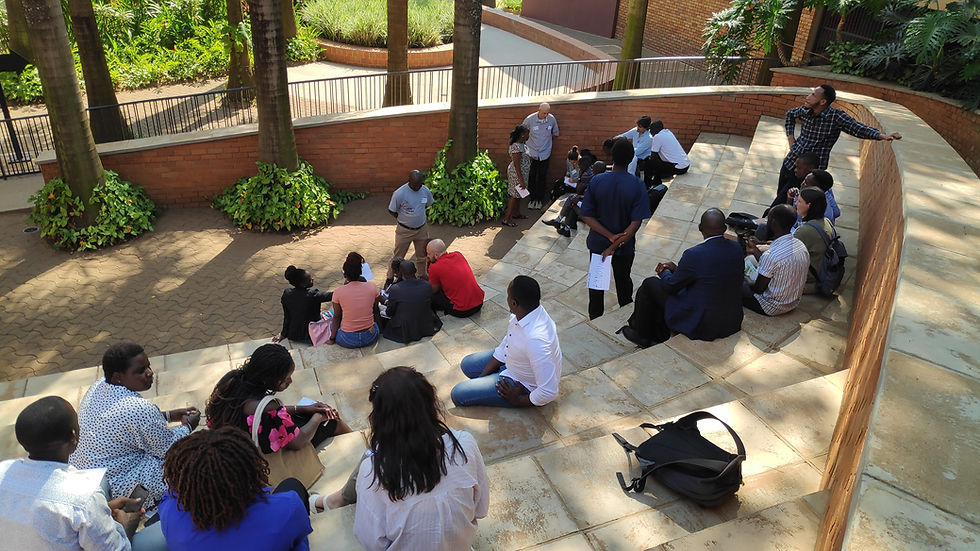Inclusive school design in East Africa
- info8381132
- Aug 21, 2023
- 4 min read
Meg Collin, Field Officer
Last month, while visiting a school in Uganda, I found myself in the unusual position of being strongly discouraged to use a ramp. I was stood at the top of it, looking down the steep and narrow switch-back slope into the sports arena, with the member of staff kindly showing me around urging me to use the steps to descend. I did go down the ramp, and safely arrived at the base after a mildly disorientating walk and slide down the smooth terrazzo, but I couldn’t help wondering who this ramp had been built for? If I, as an adult without a disability was struggling, who would benefit? Although the example is extreme, the situation was not unusual. This was far from the first time that a school ramp, provided with the good intention of improving accessibility, was both costly and ineffective.

The aforementioned ramp into a spectacular sports hall, each section less than 60cm wide.
Accessibility and inclusion are a vital aspect of school design, as is recognised by both Ugandan and Rwandan governments through accessibility requirements in national design codes (Uganda: 2010 UNAPD Accessibility Standards, Rwanda: 2009 Tronc guidelines). Children with disabilities can face many challenges to participating in education, yet it is one of the most important ways that they experience dignity and inclusion in society. Not all disabilities are physical, and those facing accessibility barriers in schools also includes those with intellectual or psychosocial impairments, those from marginalised social groups and those with temporary conditions such as broken limbs or being pregnant. When resources are limited, how can schools create accessible and inclusive environments? From my experience, the answer is not just more ramps.

Three identical classroom blocks at a secondary school each with their own ramp, which increases the material cost of each building by up to 30%. The ramps themselves are too steep for a self-propelled wheelchair and they block light to three of the rooms.
In an ideal world, every space in a school should have step-free access, however in schools with multiple-stories this becomes extremely costly in terms of lifts or ramps. Instead, the priority should be to ensure that at least one of every type of space (classroom, science lab, library etc) is wheelchair accessible, so that room allocations can be planned accordingly. Other aspects of design affecting the physical accessibility of a space are: handrails, wide corridors, slip-resistant surfaces, fixtures and fittings suitable for those with physical impairments and enough manoeuvring space for those in a wheelchair to participate fully in activities.

Wide overhangs and smooth, wide pathways at Gem Foundation enable wheelchair users to be protected from the weather as they move around.
The materiality of a school affects not just mobility impairments, but also visual, intellectual and psychological ones. Improvements can be made by removing any protruding elements in rooms or walkways and having tactile surfaces and contrasting colours around thresholds. Connection to the outside world and a soft palette of materials may help students with a form of autism feel more comfortable and less anxious in the school environment. Materials that reduce acoustic reverberation in classrooms aid those with hearing impairments.

Planting shades the walkway between buildings at Gem Foundation and a wide doorway with low door handles and an even threshold enables those in a wheelchair to easily pass through.
At a masterplanning level, smooth paths and covered walkways enable physically disabled students to move around the school unaided, giving them greater independence and dignity. A clearly organised site with consistent signposting and logical arrangement of spaces aids those with visual, hearing and intellectual impairments.

Smooth, wide paths at 1:20 gradients enable students in wheelchairs to move about unaided, while tactile landscaping helps those with visual impairments. Image © Will Boase
Both Uganda and Rwanda have designated ‘inclusive’ schools, where children with special educational needs (SEN) are integrated into mainstream schools, with support from extra teachers trained in special needs education. These schools often require additional spaces, such as areas for small groups to meet or for one-on-one support. These may be break-out spaces adjacent to classrooms or could be covered external areas. Visual displays around the school and use of symbols and colour helps those with SEN to integrate, while the capacity to access digital material – which may require electrical sockets, internet access and screens - enables alternative methods of teaching and learning designed to suit the needs of students with SEN.

A multi-purpose shaded space at Gem Foundation can be used by students to play or relax in. Low windowsills allow for easier visibility of the natural world outside.
Article 24 of the 2006 Convention on the Rights of Persons with Disabilities (CRPD)15 calls for children with disabilities to have access to ‘an inclusive, quality and free primary education and secondary education on an equal basis with others in the communities in which they live. This includes the provision of reasonable accommodations to children’s needs along with adequate support to maximize economic and social development.’ It is both possible and necessary for schools of the future to provide inclusive environments than can enable all children to thrive.




Comments